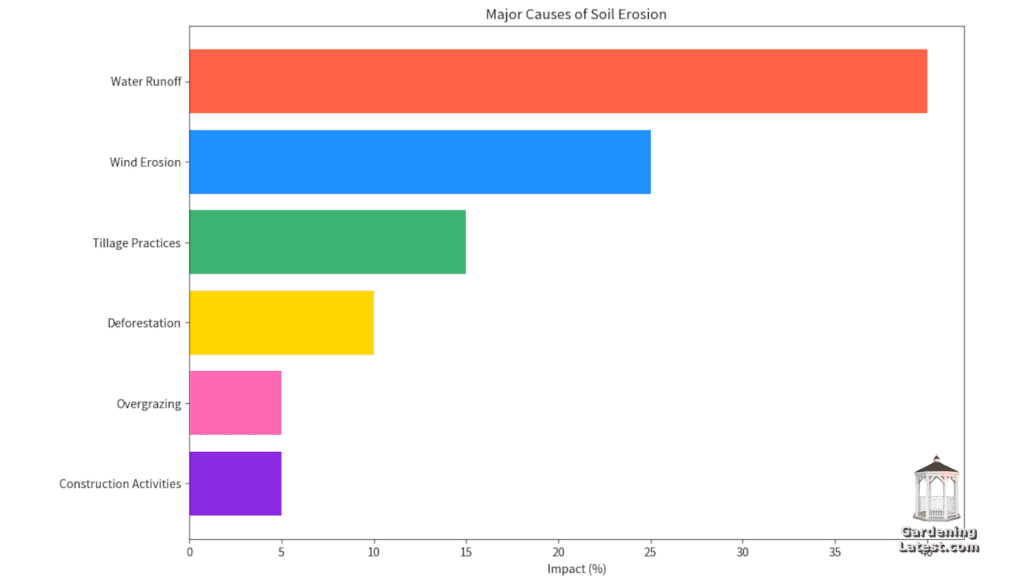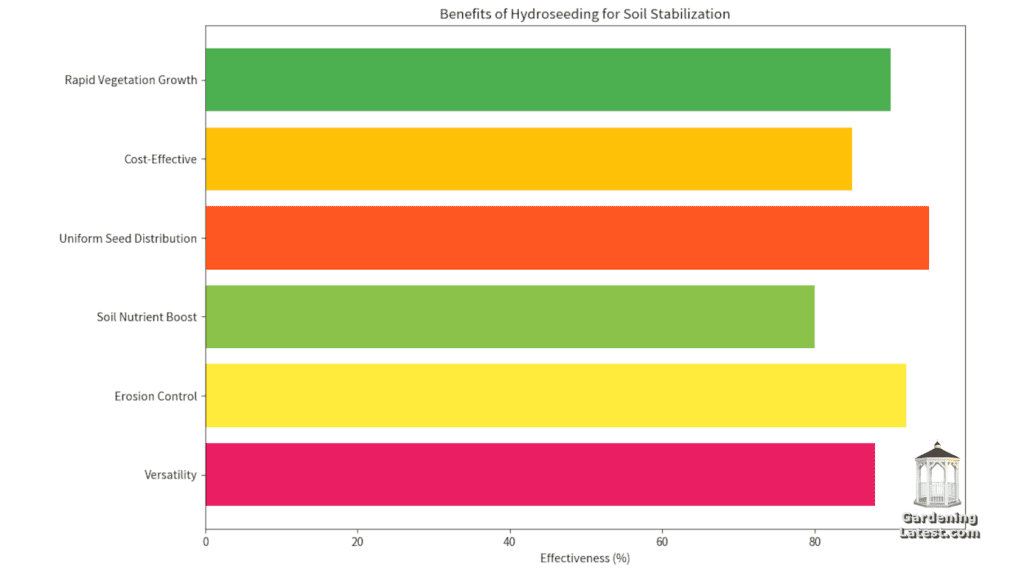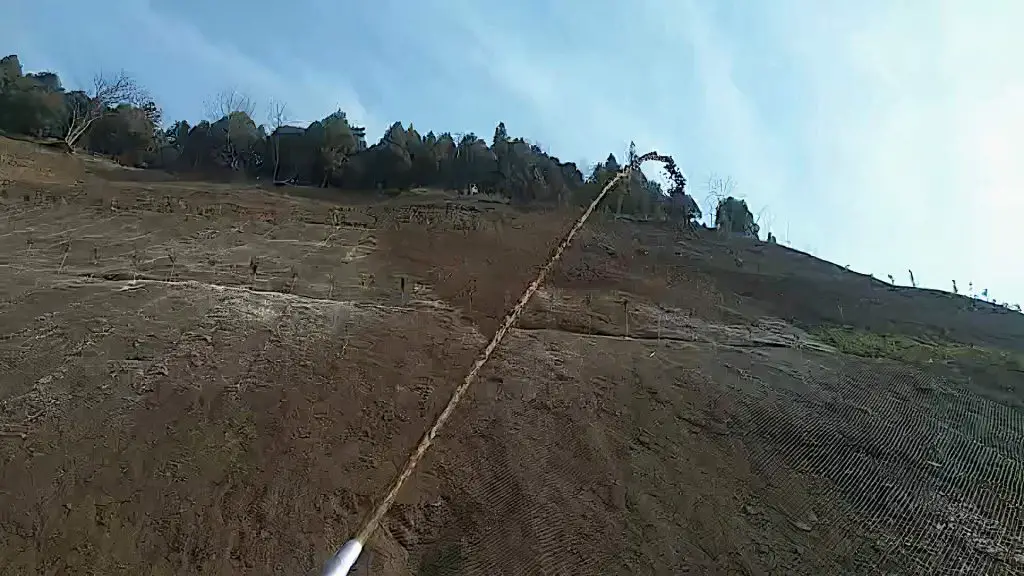Sowing the Seeds of Change: Hydroseeding for Soil Stabilization and Erosion Control
- Soil Erosion’s Pervasiveness: Soil erosion is a widespread environmental challenge, with causes ranging from natural events like water runoff and wind to human activities such as deforestation and construction. Its impact extends beyond just land degradation, affecting water quality, and biodiversity, and even contributing to climate change.
- Hydroseeding’s Dual Role: Hydroseeding serves a dual purpose in combating soil erosion. It not only promotes rapid vegetation growth, which acts as a natural barrier against erosion but also stabilizes the soil, making it less susceptible to being washed or blown away.
- Diverse Applications: Beyond just soil stabilization and erosion control, hydroseeding has a range of applications. It plays a crucial role in post-wildfire rehabilitation, landscaping, agricultural fields enhancement, and roadside construction, showcasing its versatility in land management.
- Economic and Environmental Benefits: Hydroseeding is not only cost-effective compared to traditional seeding methods but also offers environmental benefits. By enhancing soil health, reducing sediment runoff, and promoting sustainable land management practices, hydroseeding contributes to both economic development and environmental conservation.
Soil erosion is a pressing challenge that threatens our environment, agriculture, and natural resources. As the earth’s protective skin, soil plays a pivotal role in biodiversity, water quality, and human health. Factors like deforestation, extreme weather events, and certain agricultural practices exacerbate erosion, leading to detrimental impacts on ecosystem services and economic development.
These takeaways encapsulate the essence of the article, emphasizing the importance of hydroseeding in addressing the challenges of soil erosion and the broader implications for environmental sustainability.
Enter hydroseeding – a game-changer in soil stabilization and erosion control. This innovative technique involves spraying a seed mix combined with mulch onto the soil. It promotes rapid vegetation cover and enhances soil health, making it a beacon of hope for sustainability and conservation in our changing world.
Understanding Soil Erosion
Soil erosion is more than just the loss of topsoil. It’s a complex issue intertwined with climate change, deforestation, and human activities. Understanding its causes and consequences is crucial for effective land management.
Causes of Soil Erosion
- Deforestation: Removing trees weakens the soil, making it susceptible to erosion.
- Agricultural Practices: Overgrazing, tilling, and monoculture can strip the soil of its protective vegetation.
- Extreme Weather Events: Heavy rainfall, flooding, and landslides can wash away vast amounts of soil.
- Construction Practices: Building roads and structures often disturb the soil, increasing its vulnerability to erosion.
Consequences of Soil Erosion:
- Loss of Biodiversity: As topsoil disappears, many plants and animals lose their habitats.
- Reduced Agricultural Productivity: Eroded soil lacks essential nutrients, affecting food security.
- Water Quality Issues: Runoff from eroded areas can pollute water sources, impacting human health and aquatic life.
- Economic Impacts: Loss of fertile land can hamper economic development, especially in regions reliant on agriculture.
Table: Regions Most Affected by Soil Erosion in the US
| Region | Erosion Rate (tons/acre/year) | Primary Causes |
|---|---|---|
| Mountain | 6.8 | Deforestation, rainfall |
| Piedmont | 2.7 | Agriculture, construction |
| Coastal Plain | 2.2 | Flooding, agriculture |

The above bar chart provides a breakdown of the primary factors contributing to soil erosion. As depicted, water runoff is the most significant cause, followed by wind erosion and tillage practices. Having an understanding of the various elements leading to soil degradation helps explain why solutions like hydroseeding are crucial.
The Science of Hydroseeding
Hydroseeding, also known as hydromulching, is a blend of science and art. It’s a method that combines soil science with innovative technology to combat erosion and promote revegetation.
What is Hydroseeding?
At its core, hydroseeding is a process where a slurry of seeds, mulch, and binders is sprayed onto the soil. This slurry forms a protective layer, promoting seed germination and growth.
Components of Hydroseeding:
There are several components that can make up a hydroseed mix, dependent on the application
- Seeds: Depending on the region and purpose, a specific seed mix is chosen. This could range from grasses for landscaping to native plants for revegetation.
- Mulches: They retain moisture and protect the seeds. Common mulches include wood fiber, straw, and coconut.
- Binders: These help the mulch and seeds adhere to the soil, preventing them from being washed away by runoff.
Hydroseeding Process:
- Site Preparation: The land is cleared of debris and, if necessary, contoured to guide water flow.
- Mix Preparation: Seeds, mulch, and binders are mixed with water to form a slurry.
- Application: Using specialized machinery, the slurry is sprayed onto the soil.
- Maintenance: The site is monitored for seed germination and growth. Additional water or nutrients might be added as needed.
Table: Benefits of Different Mulch Types in Hydroseeding
| Mulch Type | Benefits |
|---|---|
| Wood Fiber | High water retention, biodegradable |
| Straw | Natural, provides good insulation |
| Coconut | Durable, excellent for slope stabilization |
Benefits of Hydroseeding for Soil Stabilization
Hydroseeding has emerged as a frontrunner in the realm of soil stabilization and erosion control. Its multifaceted benefits not only address the immediate concerns of soil loss but also contribute to long-term environmental sustainability and conservation.

The bar chart provides an insight into the relive benefits of using hydroseed to help provide soil stabilization and combat erosion.
Rapid Vegetation Establishment:
One of the standout advantages of hydroseeding is the speed at which vegetation establishes itself. The combination of seeds, mulch, and nutrients provides an optimal environment for germination. As a result, areas treated with hydroseeding often showcase lush greenery in a matter of weeks, aiding in biodiversity and ecosystem services.
Cost-Effectiveness:
When compared to traditional methods like sodding or manual seeding, hydroseeding proves to be more economical. The process requires fewer labor hours, and the materials used are generally less expensive. This cost-effectiveness makes it a preferred choice for large-scale agricultural and landscaping projects.
Versatility in Seed and Mulch Choices:
Hydroseeding offers flexibility in choosing the right seed mix for the specific needs of the land. Whether it’s for slope stabilization, revegetation after a wildfire, or beautifying urban spaces, there’s a seed mix tailored for the purpose. The choice of mulch, be it wood fiber, straw, or coconut, can also be customized based on the site’s requirements.
Enhancement of Soil Health:
Beyond just preventing erosion, hydroseeding contributes to the overall health of the soil. The mulch used in the process decomposes over time, enriching the soil with organic matter. This organic infusion boosts the soil’s fertility, promoting agricultural practices that are sustainable and beneficial for food security.
Environmental and Social Benefits:
Hydroseeding plays a pivotal role in environmental justice. By preventing soil erosion, it safeguards water bodies from sedimentation, ensuring water quality. The rapid vegetation growth aids in improving air quality by absorbing pollutants. On a societal level, stable soils mean safer communities, reducing risks associated with landslides and floods, thus enhancing community resilience.
Table: Comparison of Hydroseeding with Traditional Methods
| Aspect | Hydroseeding | Traditional Methods |
|---|---|---|
| Cost | Economical for large areas | Expensive, especially for large areas |
| Time for Establishment | Rapid, a few weeks | Can take months |
| Flexibility | Customizable seed and mulch choices | Limited options |
| Soil Health Impact | Enhances with organic matter | Might not enrich the soil |
| Environmental Impact | Positive, with reduced runoff and sedimentation | Can lead to more runoff |
Hydroseeding’s multifaceted benefits make it a cornerstone in modern land management practices. As we grapple with challenges posed by climate change and deforestation, solutions like hydroseeding offer a glimmer of hope. They represent the synergy of research, development, innovation, and technology in the quest for a sustainable future.
Hydroseeding Applications
The versatility of hydroseeding extends far beyond just soil stabilization. Its applications span various sectors, from agriculture to construction, showcasing its adaptability and effectiveness.

Soil Stabilization and Its Importance:
Soil serves as the foundation for most terrestrial life. Its stability ensures the health of ecosystems, supports agricultural practices, and underpins infrastructural developments. Hydroseeding plays a crucial role in maintaining this stability, especially in areas prone to erosion or those that have been disturbed by human activities.
Erosion Control in Vulnerable Areas:
Certain regions, especially those affected by deforestation, desertification, or extreme weather events, are particularly susceptible to erosion. Hydroseeding offers a rapid solution, establishing vegetation that acts as a natural barrier against soil loss. This not only protects the land but also safeguards water quality by preventing sedimentation in nearby water bodies.
Reclamation of Mining Sites:
Mining often leaves behind vast expanses of disturbed land. These areas, devoid of vegetation, are vulnerable to erosion and can become environmental hazards. Hydroseeding accelerates the revegetation process, transforming these barren zones into green landscapes. This aids in environmental justice, ensuring that industries take responsibility for restoring the lands they exploit.
Restoration of Wildfire-Affected Areas:
Wildfires can decimate vast areas, leaving behind scorched earth. The absence of vegetation makes these regions prone to ash flow and debris flow, especially during rains. Hydroseeding provides a timely solution, promoting the growth of fire-resistant plants that not only stabilize the soil but also reduce the risk of future fires.
Strengthening of Construction Sites:
Construction activities often disturb the natural soil structure. Left unchecked, these sites can contribute to erosion, especially if they are located on slopes. Hydroseeding offers a dual benefit here: it stabilizes the soil and provides a green cover, enhancing the aesthetics of the constructed space.
Beautification of Urban Landscapes:
Urban areas, with their concrete jungles, often lack green spaces. Hydroseeding offers a cost-effective solution for urban landscaping, transforming empty plots, roadside berms, and even rooftops into lush gardens. This not only enhances air quality but also contributes to the well-being and human health of city dwellers.
Table: Hydroseeding Applications and Their Benefits
| Application | Benefits |
|---|---|
| Soil Stabilization | Maintains ecosystem health, supports agriculture, underpins infrastructural developments |
| Erosion Control | Protects vulnerable areas, safeguards water quality |
| Mining Site Reclamation | Transforms barren zones, promotes environmental justice |
| Wildfire Restoration | Reduces risk of ash and debris flow, promotes growth of fire-resistant plants |
| Construction Site Strengthening | Prevents erosion on slopes, enhances aesthetics |
| Urban Landscaping | Enhances air quality, contributes to human well-being |
The myriad applications of hydroseeding underscore its importance in modern land management practices. As challenges like climate resilience and social justice come to the fore, hydroseeding stands out as a solution that marries technology with sustainability.
Challenges and Future Prospects of Hydroseeding

While hydroseeding has proven to be a revolutionary technique in soil stabilization and erosion control, it’s not without its challenges. Addressing these hurdles and understanding the future trajectory of hydroseeding is essential for its continued success.
- Challenges in Hydroseeding:
- Climatic Variability: Climate change has brought about unpredictable weather patterns. Extended droughts or heavy rainfall can impact the effectiveness of hydroseeding, affecting seed germination and growth.
- Seed Mix Selection: The choice of seeds is crucial. Using non-native or invasive species can harm local biodiversity and disrupt ecosystems.
- Maintenance: Post-application care, including watering and protection from pests, is essential for the success of hydroseeding. Neglect can lead to suboptimal results.
- Economic Constraints: While hydroseeding is cost-effective in the long run, initial costs can be a deterrent for some, especially in regions with limited resources.
- Future Prospects and Innovations:
- Research and Development: Continuous research is paving the way for more efficient hydroseeding techniques, better seed mixes, and advanced mulches that can retain more moisture.
- Policy and Regulation: As the importance of soil health and conservation gains traction, governments worldwide are likely to implement policies promoting hydroseeding, especially in erosion-prone areas.
- Public Awareness and Education: Outreach programs and educational campaigns can play a pivotal role in popularizing hydroseeding. As more people understand its benefits, its adoption is likely to rise.
- Integrated Approaches: Combining hydroseeding with other land management practices can yield even better results. For instance, integrating it with terracing or contour plowing can enhance soil stability further.
- Technology Integration: Leveraging technology, like drones for aerial hydroseeding or sensors for monitoring soil moisture, can make the process more efficient and precise.
Table: Challenges vs. Solutions in Hydroseeding
| Challenge | Potential Solution |
|---|---|
| Climatic Variability | Research on drought-resistant seed mixes, advanced mulches |
| Seed Mix Selection | Collaborate with local environmental agencies to identify native species |
| Maintenance | Develop comprehensive post-application care guides, community training |
| Economic Constraints | Government subsidies, community-driven initiatives |
As we look to the future, hydroseeding’s role in environmental sustainability, community resilience, and economic development becomes even more pronounced. By addressing its challenges and capitalizing on innovations, hydroseeding can continue to be a beacon of hope in the realm of land management and conservation.
The Broader Impact of Hydroseeding on the Environment and Society
Hydroseeding is not just a technique; it’s a movement towards a more sustainable future. Its ripple effects touch various facets of the environment and society, underscoring its significance beyond just soil stabilization.
- Environmental Benefits:
- Biodiversity Enhancement: By restoring vegetation, hydroseeding promotes a diverse range of flora and fauna. This is crucial in areas affected by deforestation or urban development, where local ecosystems may have been disrupted.
- Water and Air Quality Improvement: Vegetation acts as a natural filter. It absorbs pollutants from the air and reduces sediment runoff into water bodies, ensuring cleaner air and water.
- Climate Resilience: Vegetation cover can mitigate the effects of extreme weather events. It reduces the heat island effect in urban areas and acts as a buffer against storms and floods.
- Carbon Sequestration: Plants absorb carbon dioxide, playing a role in combating global warming. Large-scale hydroseeding can contribute to offsetting carbon emissions.
- Societal Impacts:
- Economic Development: Hydroseeding can boost local economies. It offers employment opportunities in its application and maintenance. Moreover, stabilized lands can be used for agriculture or development, driving economic growth.
- Health and Well-being: Green spaces have been linked to improved mental health. Urban areas that employ hydroseeding to create parks or green belts offer their residents a respite from the hustle and bustle, promoting mental well-being.
- Community Resilience: Stable soils reduce the risk of landslides and floods. This ensures the safety of communities, especially those in vulnerable areas.
- Education and Outreach: Hydroseeding projects can serve as educational hubs. They offer practical insights into soil science, conservation, and sustainability, fostering a culture of environmental awareness.
- Championing Social and Environmental Justice:
- Food Security: By reclaiming agricultural lands that might have been lost to erosion, hydroseeding plays a role in ensuring food security. Stable, fertile lands mean better crop yields.
- Water Conservation: Healthy soils retain more water. This is crucial in areas prone to drought, ensuring that the land remains productive even in adverse conditions.
- Promotion of Best Practices: Hydroseeding can set a precedent. Its success can encourage the adoption of other sustainable land management practices, driving a shift towards more environmentally friendly approaches in agriculture, construction, and landscaping.
Table: Broader Impacts of Hydroseeding
| Impact Area | Benefits |
|---|---|
| Environmental | Enhanced biodiversity, improved air and water quality, climate resilience, carbon sequestration |
| Societal | Economic growth, mental well-being, community safety, educational opportunities |
| Social & Environmental Justice | Food security, water conservation, promotion of sustainable practices |
In essence, hydroseeding is a testament to how human innovation can work in tandem with nature. Its broader impacts highlight the interconnectedness of our ecosystems, economies, and societies. As we move forward, embracing techniques like hydroseeding becomes not just a choice, but a responsibility towards a sustainable future.
Final Thoughts: The Path Forward with Hydroseeding
The journey of hydroseeding has taken from being a novel technique to a cornerstone of soil stabilization and erosion control is a testament to human ingenuity. Its multifaceted benefits, spanning from environmental conservation to societal well-being, make it an indispensable tool in the modern toolkit for land management.
As we face the challenges of climate change, deforestation, and rapid urbanization, the role of hydroseeding becomes even more pronounced. It offers a beacon of hope, a tangible solution that not only addresses immediate concerns but also paves the way for a sustainable future.
However, the success of hydroseeding hinges on continuous research, public awareness, and policy support. It’s a collective endeavor, requiring the collaboration of scientists, policymakers, communities, and industries.
In embracing hydroseeding, we’re not just sowing seeds on the ground; we’re planting the seeds for a greener, more resilient future. It’s a step towards harmonizing human development with nature, ensuring that as we progress, we leave no land – or person – behind.
References
- Applied Geography, Adélia N. Nunes: Impacts of Land Use and Cover Type on Runoff and Soil Erosion in A Marginal Area of Portugal
- USDA: Cropland Conversion to Grass-Based Agriculture to Reduce Soil Erosion
- Journal of Soil and Water Conservation, D.L. Babcock and R.A. McLaughlin: Erosion Control Effectiveness of Straw, Hydromulch, and Polyacrylamide in A Rainfall Simulator
